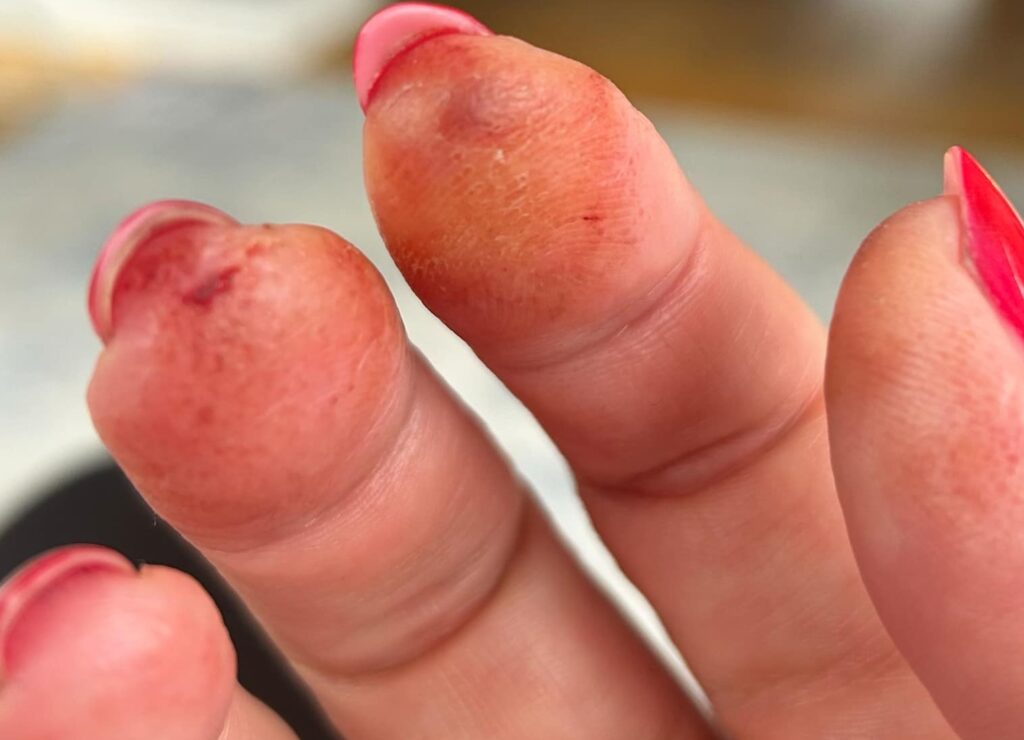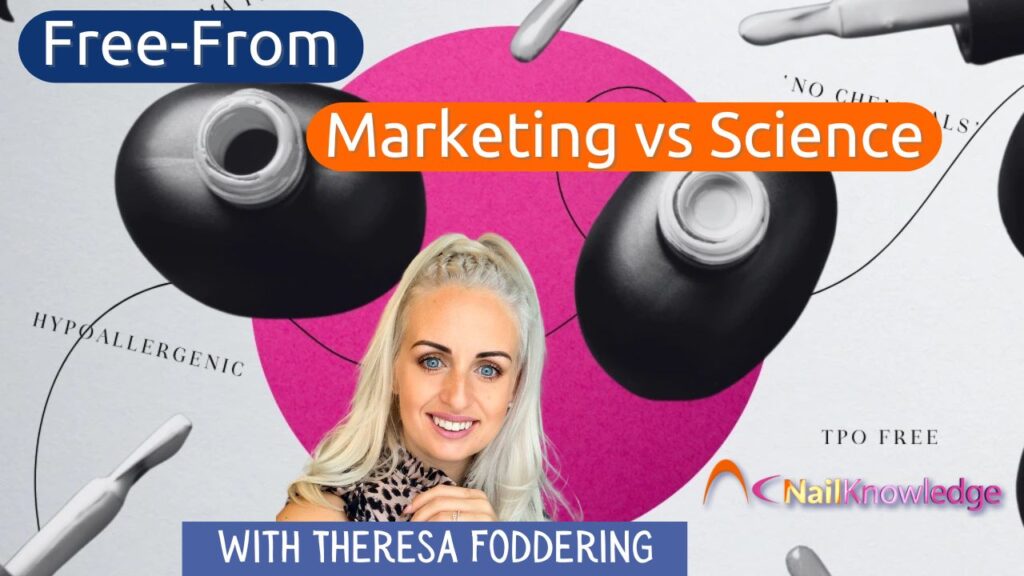Libre de Marketing vs. Ciencia: La seguridad de los productos para las uñas
As someone deeply embedded in the professional nail and products industry, I’ve seen firsthand how “free-from” claims influence buying decisions, often without a clear understanding of what they actually mean. In this blog, I want to break down the reality of these claims, the science behind allergens, and why critical thinking is beneficial and transparent when evaluating these marketing trends.
Understanding ‘Free-From’ Claims in the Nail Industry
The idea behind “free from” branding is simple: by excluding certain ingredients that have been deemed harmful or allergenic, companies suggest their products are safer or healthier. Common examples include:
- X-Free nail polishes, which claim to exclude formaldehyde, dibutyl phthalate, toluene, and other supposedly harmful chemicals.
- Sin HEMA gels marketed as a safer alternative for those prone to allergies.
- Hipoalergénico productos
Pero la verdadera pregunta es: ¿fueron alguna vez estos ingredientes una preocupación real para la mayoría de los usuarios, o se trata sólo de marketing inteligente?
And let’s not overlook the pressure applied in reverse upon companies to join “free from” formulating and marketing claims to ‘give the people what they want’. It’s a double-edged sword and no one seems to be winning.
La ciencia de los alérgenos: Todo es un alérgeno potencial
One of the biggest misconceptions in “free from” marketing is the assumption that the absence of certain ingredients makes a product safer. The truth is that every substance has the potential to cause an allergic reaction.
Por ejemplo:
- Lavender oil – A natural ingredient often used in “natural” beauty, but also a known skin allergen.
- Nueces – Completely natural but can be deadly to those with severe allergies.
- Agua – Even water can cause irritant contact dermatitis (ICD) with overexposure.
Yet, we don’t see brands marketing their gels as “free from lavender or nuts,” even though they are just as capable of causing allergic reactions as the ingredients being demonized. This selective marketing plays on fear rather than fact.
Los acrilatos están en todas partes: Productos domésticos y exposición diaria
Acrylates, particularly those being villainized in nail products, are not unique to the nail industry. Many of these chemicals are found in productos domésticos e industriales de uso cotidianoSin embargo, nadie se apresura a eliminarlos de esas aplicaciones.
Por ejemplo:
- Etilenglicol dimetacrilato (EGDMA) – Used in plastic bottles for soft drinks, dental materials, printing inks, automobile antifreeze, and engine-cooling liquids.
- Metacrilato de metilo (MMA) – Used in medical prosthetics, dental work, and industrial applications, yet banned in liquid monomer form in some countries for nails due to misuse, not because of toxicity when used correctly.
- Hidroxipropilmetacrilato (HPMA) – Found in medical-grade adhesives, contact lenses, and of course, nail coatings.
- Metacrilato de tetrahidrofurfurilo (THFMA) – Used in dental materials, artificial nails, and 3D printing, yet has been flagged for its potential allergenic effects.
- Monometacrilato de propilenglicol (PGMA) – Found in adhesives, cosmetics, and medical devices, but rarely discussed despite being a known allergen.
- Triacrilato de trimetilolpropano (TMPTA) – A multifunctional acrylate monomer used in UV-curable coatings, adhesives, and inks, but like other acrylates, has the potential to cause skin sensitization and allergic reactions in some individuals.
- Metacrilato de bencilo – Used in artificial nail products, dental materials, and medical devices. It contributes to the durability of polymer formulations but, like other methacrylates, has the potential to cause allergic reactions in sensitive individuals.
Esto plantea una pregunta importante: Si estos productos químicos se utilizan con seguridad en otras industrias sin histeria colectiva, ¿por qué la industria de las uñas es tan reactiva a cada tendencia de ingredientes?

Irritantes frente a alérgenos: Conozca la diferencia para la seguridad del técnico de uñas
Otro punto clave que a menudo se ignora en estos debates es la diferencia entre alérgenos e irritantes. No todos los ingredientes que suenan preocupantes son alérgenos; algunos son simplemente irritantes cuando se utilizan de forma inadecuada o en altas concentraciones.
Por ejemplo:
- Acetato de etilo – A common solvent in nail polish and removers, classified as an irritant rather than an allergen.
- Acetona – A well-known, widely used solvent in nail products that can cause skin and respiratory irritation with overexposure but is not classified as an allergen.
- Methacrylic Acid (MAA) – A key organic component used to maximize adhesion between the nail and artificial coating. It is highly reactive and can cause skin and respiratory irritation upon direct exposure. Not considered a strong allergen but certainly a strong irritant.
Entonces, ¿dónde ponemos el límite? ¿Estamos optando por vivir con miedo, eliminando todo posible alérgeno independientemente del contexto? ¿O simplemente estamos esperando a que nos dicte el pánico el próximo ingrediente?
La controversia del HEMA: ¿Intercambio de ingredientes o progreso real?
One of the biggest ingredient shifts we’ve seen in recent years is the demonization of HEMA (Hydroxyethyl Methacrylate). Initially flagged due to allergic reactions in some users, the backlash against HEMA led to the rise of HEMA-free alternatives using IBOA (Isobornyl Acrylate) and HPMA (Hydroxypropyl Methacrylate). But now, we’re seeing the same cycle—concerns beginning to emerge over these replacement ingredients….
Esto plantea una cuestión crítica: ¿Realmente estamos haciendo productos más seguros, o simplemente jugando a un juego interminable de intercambio de ingredientes?
The truth is any acrylate or methacrylate-based system carries a potential risk of allergy. The real solution isn’t just removing ingredients but focusing on proper education, safe application, and correct handling.
I have worked with, handled, and discussed formulations for over 20 years—before the panic, before the quick-fix courses, and before the constant, in-your-face marketing. I’m all for growth, knowledge, and awareness, but I often question: how did we get here? And will we ever find a way out?
Pensamiento crítico: ¿Qué son los productos para las uñas? Realmente ¿Libre de?
Whenever I’m asked, “What’s the best free-from brand?” mi respuesta es: “I can tell you what it’s NOT free from.”
I then list random natural allergens—lavender, pollen, nuts—to drive home the point that free from does not mean safer. More often than not, this sparks a “lightbulb moment,” where professionals realize how flawed this approach is.
The only time I’ve ever received pushback was from someone affiliated with a brand that heavily markets itself as 10-free. They argued that I couldn’t dismiss something I didn’t understand. I clarified that I don’t misunderstand—I simply refuse to support misleading marketing designed to manipulate professionals and consumers for profit. Se hizo el silencio.
La conversación REAL: Uso y aplicación seguros de productos para las uñas
En lugar de fijarse en what’s NOT in our productstenemos que cambiar la conversación a cómo utilizarlos con seguridad y eficacia. Es decir:
- Ventilación y extracción adecuadas en los salones.
- Llevar guantes.
- Mantener los espacios de trabajo, el equipo y las botellas de producto limpios y sin residuos.
- Aplicación correcta para minimizar el contacto con la piel.
- Educar a los profesionales (y a los clientes) sobre los problemas de seguridad reales en lugar de sobre el marketing basado en el miedo.
El objetivo debe ser siempre science-backed education, not chasing the next “bad” ingredient.
Referencias
- DermNet NZ (s.f.) Alergia al acrilato. Disponible en: https://dermnetnz.org/topics/allergy-to-acrylate (fecha de consulta: 25/04/03).
- Steunebrink, I.M., de Groot, A. y Rustemeyer, T. (2024) ‘Contact allergy to acrylate-containing nail cosmetics: A retrospective 8-year study’, Dermatitis de contacto, 90(3), pp. 262–265. Available at: https://pubmed.ncbi.nlm.nih.gov/38093676/ (fecha de consulta: 03/03/25)
- Biblioteca Nacional de Medicina (s.f.) Tetrahydrofurfuryl Methacrylate – GHS Classification. Disponible en: https://pubchem.ncbi.nlm.nih.gov/compound/Tetrahydrofurfuryl-Methacrylate#section=GHS-Classification (fecha de consulta: 25/04/03).
- Asociación Británica de Dermatólogos (2018) Los dermatólogos alertan sobre la epidemia de alergia a las uñas artificiales en el Reino Unido. Disponible en: https://www.bad.org.uk/dermatologists-issue-warning-about-uk-artificial-nail-allergy-epidemic/ (fecha de consulta: 28/02/25).
- DermNet NZ (s.f.) Alergia de contacto al propilenglicol. Disponible en: https://dermnetnz.org/topics/contact-allergy-to-propylene-glycol (fecha de consulta: 28/02/25).
- Wen, L., Zhang, X., Wang, M., Wang, W., Gao, Y. y Zhang, J. (2017) ‘Effect of propylene glycol monomethacrylate on allergic reactions in humans: A systematic review’, Revista de Alergia e Inmunología Clínica, 140(2), pp. 500–507. Available at: https://pubmed.ncbi.nlm.nih.gov/28656588/ (fecha de consulta: 25/07/03)
- Departamento de Sanidad de Nueva Jersey (s.f.) Hoja informativa sobre sustancias peligrosas: Acetona. Disponible en: https://nj.gov/health/eoh/rtkweb/documents/fs/0841.pdf (fecha de consulta: 25/05/03).
- Liu, X. et al. (2023) ‘Occupational exposure to acrylates and associated health risks’, Perspectivas de salud medioambiental. Disponible en: https://pmc.ncbi.nlm.nih.gov/articles/PMC9823182/ (fecha de consulta: 25/05/03).
- Gobierno británico (2022) Acetona: Información general. Disponible en: https://www.gov.uk/government/publications/acetone-properties-and-incident-management/acetone-general-information (fecha de consulta: 25/04/04).
- Fowler, J. F. Jr. (2006) ‘Acrylate allergy in nail cosmetics’, Dermatitis, 17(2), pp. 57-60. Disponible en: https://pubmed.ncbi.nlm.nih.gov/16596768/ (fecha de consulta: 28/02/25).
- Department of Toxic Substances Control (2024) Methyl Methacrylate in Nail Products. Available at: https://dtsc.ca.gov/wp-content/uploads/sites/31/2024/10/Profile_Methyl-Methacrylate-in-Nail-Products_FINAL.pdf (fecha de consulta: 25/05/03).
- Biblioteca Nacional de Medicina (2021) Alergia a los acrilatos y exposición profesional. Disponible en: https://pmc.ncbi.nlm.nih.gov/articles/PMC8501444/ (Consulta: 25/03/09).
- Agencia Europea de Sustancias y Preparados Químicos (s.f.) Benzyl Methacrylate – Substance Information. Disponible en: https://echa.europa.eu/substance-information/-/substanceinfo/100.017.887#:~:text=Warning!,and%20may%20cause%20respiratory%20irritation.&text=This%20substance%20is%20registered%20under,industrial%20sites%20and%20in%20manufacturing (Consulta: 25/03/09).


